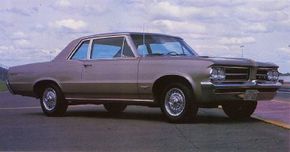The Big Bang in the evolution of modern muscle cars is the 1964 Pontiac Tempest GTO. This is where it began: a midsize automobile with a big, high-power V-8 marketed as an integrated high-performance package -- the very definition of the muscle car.
Advertisement
To create the GTO, Pontiac sidestepped GM's prohibition on intermediate-sized cars having engines over 330 cid. In a ploy that didn't require corporate approval, Pontiac made its 389-cid V-8 part of a $296 option package for the new Tempest. The name Gran Turismo Omologato was boldly appropriated from the Ferrari GTO. Roughly translated, it means a production grand touring machine sanctioned for competition.
Pontiac hoped to sell 5,000 '64 GTOs; it sold 32,450. The Goat, as it was affectionately dubbed, generated a cult following and sent rivals scrambling to come up with similar machines.

To create an engine worthy of its original, Pontiac fortified the 389 with a high-lift cam and the 421-cid V-8's high-output heads. The GTO had 325 bhp with the standard Carter four-barrel. About 8,250 of the cars were ordered with the extra-cost Tri-Power setup -- three Rochester two-barrels -- and were rated at 348 bhp. Both versions had 10.75:1 compression and 428 lb-ft of torque. The standard three-speed manual and optional four-speed used Hurst linkages; a two-speed automatic also was optional.
A thick front sway bar, heavy-duty shocks, stiffened springs, and high-speed 14-inch tires were included. A $75 "roadability group" added sintered metallic brake linings and a limited-slip diff. The sporting attitude carried over inside, where all GTOs got bucket seats and an engine-turned aluminum instrument surround.

Four-barrel Goats typically ran 0-60 mph in about 7.5 seconds and the quarter in 15.7 at 92 mph. Tri-Power GTOs were consistently quicker and added immeasurably to the car's mystique.
Return to Classic Muscle Cars Library.
- Pontiac ignited the classic muscle car era with a stroke of marketing genius. See profiles, photos, and specifications of Pontiac muscle cars.
- Muscle cars came in many shapes and sizes. Here are features on more than 100 muscle cars, including photos and specifications for each model.
- Muscle cars created their own culture. To learn about it, read How Muscle Cars Work.
These muscle car profiles include photos and specifications for each model:
- Cougar pulled out of Mustang's shadow with the striped and spoilered 1969 Mercury Cougar Eliminator.
- Beep, beep! Make way for one of the baddest muscle cars of all time, the 1970 Plymouth Road Runner Hemi.
- The 1970 Pontiac Firebird Trans Am combined sports-car handling and muscle car power.
- An all-aluminum, race-proven V-8 defined the rare and wicked 1969 Chevrolet Camaro ZL1.
For related car information, go to these articles:
- The engine is what gives a muscle car its flamboyant personality. To learn everything you need to know about car engines, see How Car Engines Work.
- Muscle cars wouldn't have much muscle without horsepower -- but what exactly is horsepower? How Horsepower Works answers that question.
- NASCAR race cars embody the muscle car philosophy of power. Read How NASCAR Race Cars Work to find out what makes these charged-up racers go.
- Are you thinking of buying a 2007 muscle car, or any other car? See Consumer Guide Automotive's New-Car Reviews, Prices, and Information.
Advertisement
